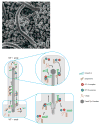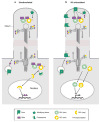Cilia and developmental signaling
- PMID: 17506691
- PMCID: PMC2094042
- DOI: 10.1146/annurev.cellbio.23.090506.123249
Cilia and developmental signaling
Abstract
Recent studies have revealed unexpected connections between the mammalian Hedgehog (Hh) signal transduction pathway and the primary cilium, a microtubule-based organelle that protrudes from the surface of most vertebrate cells. Intraflagellar transport proteins, which are required for the construction of cilia, are essential for all responses to mammalian Hh proteins, and proteins required for Hh signal transduction are enriched in primary cilia. The phenotypes of different mouse mutants that affect ciliary proteins suggest that cilia may act as processive machines that organize sequential steps in the Hh signal transduction pathway. Cilia on vertebrate cells are likely to be important in additional developmental signaling pathways and are required for PDGF receptor alpha signaling in cultured fibroblasts. Cilia are not essential for either canonical or noncanonical Wnt signaling, although cell-type-specific modulation of cilia components may link cilia and Wnt signaling in some tissues. Because ciliogenesis in invertebrates is limited to a very small number of specialized cell types, the role of cilia in developmental signaling pathways is likely a uniquely vertebrate phenomenon.
Figures




References
-
- Adler PN. Planar signaling and morphogenesis in Drosophila. Dev Cell. 2002;2(5):525–35. - PubMed
-
- Afzelius BA. A human syndrome caused by immotile cilia. Science. 1976;193(4250):317–9. - PubMed
-
- Albrecht-Buehler G. Phagokinetic tracks of 3T3 cells: parallels between the orientation of track segments and of cellular structures which contain actin or tubulin. Cell. 1977;12(2):333–9. - PubMed
-
- Ansley SJ, Badano JL, Blacque OE, Hill J, Hoskins BE, et al. Basal body dysfunction is a likely cause of pleiotropic Bardet-Biedl syndrome. Nature. 2003;425(6958):628–33. - PubMed
Publication types
MeSH terms
Substances
Grants and funding
LinkOut - more resources
Full Text Sources

